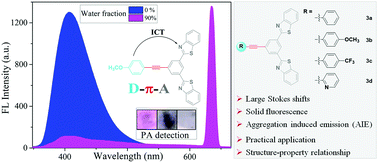Rational design and synthesis of Y-shaped fluorophores with multifarious emission properties and their application in the sensitive detection of PA†
Abstract
Four new Y-shaped D–π–A compounds 3a–3d with an aryl acetylene moiety bearing two benzothiazole branches were concisely synthesized in two steps. Their photophysical properties in solution and powder states have been investigated and further confirmed via theoretical calculations. All compounds 3a–3d show strong solid-state fluorescence, aggregation induced emission and near-infrared fluorescence. And, as anticipated, the modulation of the substituent on the aryl acetylene unit can largely affect the charge density of molecules as well as their fluorescence properties. Noteworthily, compound 3b with methoxy as an electron-donating group presents significant solvatochromism because of its obvious intramolecular charge transfer effect. In addition, compounds 3a–3d in the aggregated state (H2O/THF, v/v, 9/1) can be developed as a near-infrared fluorescent probe for picric acid (PA). Their limits of detection have been found to be 3.1 × 10−7, 6.1 × 10−8, 3.3 × 10−7 and 4.6 × 10−7 M, respectively. Among them, 3b is the best design. Based on the results of 1H NMR, SEM, DLS, lifetime and DFT calculations, aggregation caused quenching and photoinduced electron transfer have been revealed to be responsible for the quenching mechanism of detecting PA. Importantly, probe 3b has also been successfully used to detect PA not only in real water samples with interferences, but also on 3b-coated Whatman filter paper strips.



 Please wait while we load your content...
Please wait while we load your content...